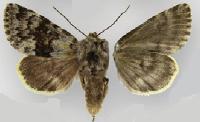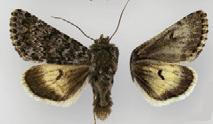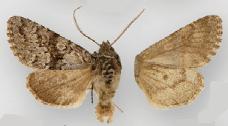
Lasionycta is a genus of moths of the family Noctuidae.

Lasionycta staudingeri is a moth of the family Noctuidae. It can be found from Oppland to Finland and Norway in Europe, as well as Siberia and North America.

Lasionycta leucocycla is a moth of the family Noctuidae. It can be found in Scandinavia, Siberia and northern North America.

Lasionycta skraelingia is a moth of the family Noctuidae. It has a Holarctic distribution, occurring from Scandinavia to north-western North America. In North America this species is known from three specimens from Windy Pass, Ogilvie Mountains, Yukon.

Lasionycta taigata is a moth of the family Noctuidae. It occurs in open peatlands and fens in the taiga zone from Labrador, Churchill, Manitoba, and central Yukon, southward to northern Maine, northern Minnesota, and south-western Alberta.

Lasionycta secedens is a moth of the family Noctuidae. It has a Holarctic distribution. North American populations are distributed from Labrador, northern Manitoba, and Alaska, southward to northern Maine, northern Minnesota, and south-central British Columbia. Subspecies bohemani occurs in northern Eurasia, Alaska and Yukon.

Lasionycta subdita is a moth species of the family Noctuidae, first described in 1860 by Heinrich Benno Möschler. Its MONA number is 10356.

Lasionycta coracina is a moth of the family Noctuidae. It is found in the Richardson and British Mountains in northern Yukon, adjacent Northwest Territories, and Cape Thompson in north-western Alaska.

Lasionycta benjamini is a moth of the family Noctuidae. It is found in the Sierra Nevada of California and in the mountains of Nevada and Colorado.

Lasionycta perplexa is a moth of the family Noctuidae. It is widely distributed from southern Alaska and Yukon in the north to California, Utah, and Colorado in the South. A disjunct population is found on the east coast of Hudson Bay at Kuujjuaraapik.

Lasionycta subfuscula is a moth of the family Noctuidae. It is found from south-western British Columbia and south-western Alberta south to southern Oregon in the west and to southern Colorado and Utah in the Rocky Mountains.

Lasionycta dolosa is a moth of the family Noctuidae first described by William Barnes and Foster Hendrickson Benjamin in 1923. It is found in the Rocky Mountains of Colorado.

Lasionycta subfumosa is a moth of the family Noctuidae. It is found from Victoria Island and Banks Island in the Northwest Territories and the Darby Mountains on the Seward Peninsula of Alaska.

Lasionycta quadrilunata is a species of moth in the family Noctuidae. It is found from south-central Alaska down the spine of the Rocky Mountains to Colorado.

Lasionycta lagganata is a moth of the family Noctuidae first described by William Barnes and Foster Hendrickson Benjamin in 1924. It is only known from three localities in south-western Canada: Banff and Waterton national parks in Alberta and the Purcell Mountains in south-eastern British Columbia.

Lasionycta phoca is a moth of the family Noctuidae. It occurs in eastern and central Canada with records from Labrador to the west coast of Hudson Bay.

Lasionycta uniformis is a moth of the family Noctuidae. It is widely distributed in the mountains of western North America. It occurs from southern Yukon to northern California and Colorado, with an isolated population in eastern Quebec.

Lasionycta impingens is a moth of the family Noctuidae. It occurs from southern Yukon to Colorado.

Psammopolia is a genus of moths of the family Noctuidae.

Psammopolia wyatti is a moth of the family Noctuidae first described by William Barnes and Foster Hendrickson Benjamin in 1926. It occurs in western North America from southern Oregon to the Queen Charlotte Islands of British Columbia. The moth has been included in both 1983 and 2010 MONA indices.
This page is based on this
Wikipedia article Text is available under the
CC BY-SA 4.0 license; additional terms may apply.
Images, videos and audio are available under their respective licenses.

